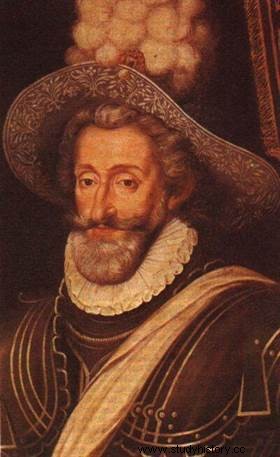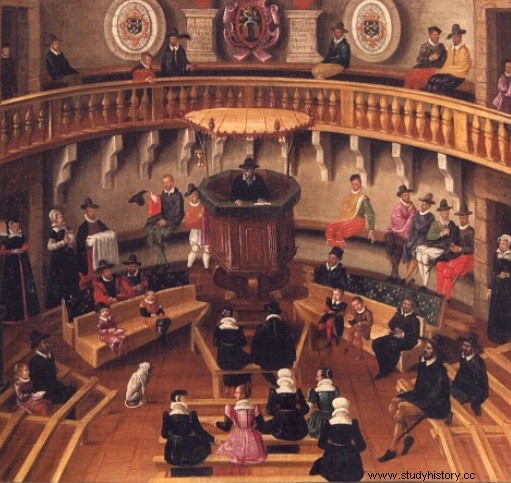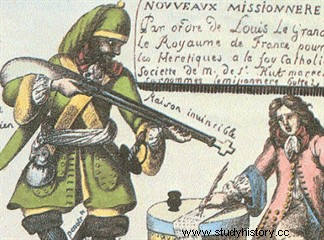 Signed on April 13, 1598 by King Henry IV at the end of the Wars of Religion, the Edict of Nantes fixed the status of Protestants in the kingdom of France. Relatively favorable to the Huguenots, to whom he attributed freedom of worship, civil equality as well as strongholds, he was dismissed by Louis XIV in 1685. With the Edict of Nantes, Henri IV appears today as a champion of tolerance because it puts in place unique legislation in Europe. Nevertheless, the text presented numerous restrictions which prevented the spread of Protestantism in France.
Signed on April 13, 1598 by King Henry IV at the end of the Wars of Religion, the Edict of Nantes fixed the status of Protestants in the kingdom of France. Relatively favorable to the Huguenots, to whom he attributed freedom of worship, civil equality as well as strongholds, he was dismissed by Louis XIV in 1685. With the Edict of Nantes, Henri IV appears today as a champion of tolerance because it puts in place unique legislation in Europe. Nevertheless, the text presented numerous restrictions which prevented the spread of Protestantism in France.
Henri IV, promoter of tolerance
Religious wars had divided France since 1562. In 1572, Catholics deemed the Edict of Beaulieu-lès-Loches (1576) too favorable to Protestants. Henri III rehabilitates the victims of the Saint-Barthélemy massacres and allows the Huguenots to organize their worship in certain cities. In 1576, Catholics then formed the League to restore order in the kingdom of France. They initially opposed Henri III, who retracted in 1577. After the death of the king on August 2, 1589, the leaguers supported Charles de Bourbon against Henri de Navarre, successor designated by Henri III. But the latter won thanks to his military successes. In 1593, under the advice of his mistress, Gabrielle d'Estrées, he recanted Protestantism.
 With the Edict of Nantes, Henry IV granted freedom of worship in 1598. Thanks to him, Protestants can organize their religious practices on their premises. In 1598, no other country had such legislation and Henri IV then appeared as the representative of tolerance. His decision reflects an important influence at that time, that of the humanist current on the sovereigns. Thus, François I was already slow to repress the Protestants at the beginning of the sixteenth century. Similarly, Charles Quint authorized the signing of the Peace of Augsburg in 1555 to put an end to the wars of religion in his empire. But the freedom it grants concerns only the princes who, in turn, impose their choice within their territory. On the other hand, that of Henri IV touches all his subjects.
With the Edict of Nantes, Henry IV granted freedom of worship in 1598. Thanks to him, Protestants can organize their religious practices on their premises. In 1598, no other country had such legislation and Henri IV then appeared as the representative of tolerance. His decision reflects an important influence at that time, that of the humanist current on the sovereigns. Thus, François I was already slow to repress the Protestants at the beginning of the sixteenth century. Similarly, Charles Quint authorized the signing of the Peace of Augsburg in 1555 to put an end to the wars of religion in his empire. But the freedom it grants concerns only the princes who, in turn, impose their choice within their territory. On the other hand, that of Henri IV touches all his subjects.
Edict of Nantes:between concessions and restrictions
In 1598, Protestants represented only a small part of the French population. They mainly belong to the elites of certain regions such as Aquitaine, Languedoc, Normandy or the Loire Valley. Nevertheless, they exert significant political and military pressure. With the Edict of Nantes, they obtained some privileges, but their religion did not develop. Minority, they must accept many compromises. After forty years of struggle, the negotiations took several months. This explains the complexity of the text, made up of 95 articles to which 3 other documents are attached.
 Above all, the negotiators hope to achieve peace through this piece of legislation. With the Edict of Nantes, every French citizen now has the right to choose their religion. Huguenots can build places of worship. However, the practice is limited to certain fiefs, possessions or concessions. They cannot set up a temple in Paris. On the other hand, 32 strongholds, called "safety", are installed, especially in Languedoc. They are given to them in the hope of maintaining peace. Finally, on the judicial level, the courts include Catholic and Protestant judges.
Above all, the negotiators hope to achieve peace through this piece of legislation. With the Edict of Nantes, every French citizen now has the right to choose their religion. Huguenots can build places of worship. However, the practice is limited to certain fiefs, possessions or concessions. They cannot set up a temple in Paris. On the other hand, 32 strongholds, called "safety", are installed, especially in Languedoc. They are given to them in the hope of maintaining peace. Finally, on the judicial level, the courts include Catholic and Protestant judges.
The text also provides for the restoration of the Catholic religion throughout the kingdom and the restitution of property stolen from the clergy. The Catholics obtain numerous compensations, especially in the towns where they remain powerful. Thus, in Dijon. in Toulouse, Beauvais or Châlons no temple can be built. In these same cities, preaching, opening schools or publishing works remained strictly forbidden to Protestants, while Catholics enjoyed these privileges throughout the kingdom. In addition to these restrictions, the application of the edict is subject to the royal will. This is why the freedoms of the Protestants are attenuated after the reign of Henri IV. Thus, the very text hinders the development of the new religion in France.
The revocation of the Edict of Nantes by Louis XIV
The Edict of Nantes, Edict of Tolerance, created a deeply original situation, by instituting a dual State, both Catholic and Protestant. The Protestants formed a sort of state within the state, much to the displeasure of the Catholics. The edict was never fully enforced, even during the reign of Henry IV. By the edict of grace of Alès, in 1629, the cardinal of Richelieu, minister of Louis XIII, abrogated its political clauses. The persecution of the Huguenots resumed under the reign of Louis XIV, who feared that his Protestant subjects, numerous in the West and the South, would become the allies of a foreign power (United Provinces or England) and wished to restore unity. of the Church of France.
 The ruler first tried to convert them by persuasion, but after 1679 and especially 1681 he directed towards an increasingly violent repressive policy (dragonnades). When the Edict of Nantes was revoked by the Edict of Fontainebleau in 1685, nearly 300,000 Protestants, among the most brilliant subjects of the kingdom, emigrated. The repression which then fell on the Protestants provoked, in 1702, the bloody revolt of the camisards, in the Cévennes. Despite the persecutions, Calvinism survives clandestinely within the "desert church".
The ruler first tried to convert them by persuasion, but after 1679 and especially 1681 he directed towards an increasingly violent repressive policy (dragonnades). When the Edict of Nantes was revoked by the Edict of Fontainebleau in 1685, nearly 300,000 Protestants, among the most brilliant subjects of the kingdom, emigrated. The repression which then fell on the Protestants provoked, in 1702, the bloody revolt of the camisards, in the Cévennes. Despite the persecutions, Calvinism survives clandestinely within the "desert church".
To go further
- The Edict of Nantes and its revocation, by Janine Garrisson. History Points, 1987.
- The Edict of Nantes, by Bernard Cottret. Tempus, 2016.
